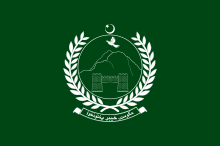North-West Frontier Province
The North-West Frontier Province (NWFP; Pashto: شمال لویدیځ سرحدي ولایت) was a province of British India and later of Pakistan. It was established in 1901 and known by this name until 2010. The area became Khyber Pakhtunkhwa province on 19 April 2010 when the Eighteenth Amendment was signed by President Asif Ali Zardari.
| North-West Frontier Province شمال لویدیځ سرحدي ولایت | |||||||||||
|---|---|---|---|---|---|---|---|---|---|---|---|
| Former province of British India & Pakistan | |||||||||||
| 1901–1955 1970–2010 | |||||||||||
 Flag | |||||||||||
 Location within Pakistan | |||||||||||
| Area | |||||||||||
• 1901 | 100,142[1][2] km2 (38,665 sq mi) | ||||||||||
| Population | |||||||||||
• 1901 | 30,523,371 | ||||||||||
| History | |||||||||||
• Established | 9 November 1901 | ||||||||||
| 19 April 2010 | |||||||||||
| |||||||||||
| Today part of | Khyber Pakhtunkhwa, Pakistan | ||||||||||
| www | |||||||||||
 |
| This article is part of the series |
| Former administrative units of Pakistan |
|---|
|
Original provinces
|
|
One-unit provinces |
|
Other subdivisions |
The province covered an area of 70,709 km², including much of the current Khyber Pakhtunkhwa but excluding the former princely states of Amb, Chitral, Dir, Phulra, and Swat, and the Federally Administered Tribal Areas. The capital was the city of Peshawar, and the province was composed of six divisions (Bannu, Dera Ismail Khan, Hazara, Kohat, Mardan, and Peshawar; Malakand was added later as seventh division). Until 1947, the province was bordered by five princely states to the north, the minor states of the Gilgit Agency to the northeast, the province of West Punjab to the east and the province of Balochistan to the south. Afghanistan lay to the northwest, with the Federally Administered Tribal Areas forming a buffer zone.
Formation
The northwestern frontier areas were annexed to India by the British after the Second Sikh War (1848–49). The territories thenceforth formed a part of the Punjab until the province, then known as North-West Frontier Province, was created in 1901.[3] This region along with the 'Frontier Tribal Areas' acted as a 'buffer' zone with Afghanistan.
Inside Pakistan
Before the Partition of India, the 1947 North-West Frontier Province referendum was held in July 1947 to decide the future of NWFP, in which the people of the province decided in favor of joining Pakistan. However, the then Chief Minister Dr Khan Sahib, along with his brother Bacha Khan and the Khudai Khidmatgars, boycotted the referendum, citing that it did not have the options of the NWFP becoming independent or joining Afghanistan.[4][5]
As a separate province, the NWFP lasted until 1955 when it was merged into the new province of West Pakistan, under the One Unit policy announced by Prime Minister Chaudhry Mohammad Ali. Mianwali and Attock were removed from it and merged with Punjab. It was recreated after the dissolution of the One Unit system and lasted under its old nomenclature until April 2010, when it was renamed as the 'Khyber Pakhtunkhwa' province.
Government
The offices of Governor and Chief Minister of the North-West Frontier Province lasted until 14 October 1955.
| Tenure | Governors of the North-West Frontier Province [6] |
|---|---|
| 14 August 1947 – 8 April 1948 | Sir George Cunningham |
| 8 April 1948 – 16 July 1949 | Sir Ambrose Dundas Flux Dundas |
| 16 July 1949 – 14 January 1950 | Sahibzada Mohammad Kursheed |
| 14 January 1950 – 21 February 1950 | Mohammad Ibrahim Khan Jhagra (acting) |
| 21 February 1950 – 23 November 1951 | Ismail Ibrahim Chundrigar |
| 24 November 1951 – 17 November 1954 | Khwaja Shahabuddin |
| 17 November 1954 – 14 October 1955 | Qurban Ali Khan |
| 14 October 1955 | North-West Frontier Province dissolved |
| Tenure | Chief Ministers of the North-West Frontier Province [6] | Political party |
|---|---|---|
| 1 April 1937 – 7 September 1937 | Sir Sahibzada Abdul Qayyum Khan | Non-party government nominee |
| 7 September 1937 – 10 November 1939 | Khan Abdul Jabbar Khan (1st time) | Indian National Congress |
| 10 November 1939 – 25 May 1943 | Governor's rule | |
| 25 May 1943 – 16 March 1945 | Sardar Aurangzeb Khan | Muslim League |
| 16 March 1945 – 22 August 1947 | Khan Abdul Jabbar Khan (2nd time) | Indian National Congress |
| 14 August 1947 | Independence of Pakistan | |
| 23 August 1947 – 23 April 1953 | Abdul Qayyum Khan Kashmiri | Pakistan Muslim League |
| 23 April 1953 – 18 July 1955 | Sardar Abdur Rashid Khan | |
| 19 July 1955 – 14 October 1955 | Sardar Bahadur Khan | |
Demographics
At independence there was a clear Muslim Pashtun majority in then North-West Frontier Province, although there were some small minorities of Hindus and Sikhs. The languages of the North-West Frontier Province included Pashto, Hindko, Kohistani and others, although most of the population spoke Pashto. Prior to the arrival of the British, the official language, for governmental uses and such, was Persian.
Notes
- Area with Native States in 1901. Province area excluding Native States was 34 169 km2 (13 193 sq mi).
- The Imperial Gazetteer of India 1908, p. 46.
- "Khyber Pakhtunkhwa | province, Pakistan". Encyclopedia Britannica. Retrieved 9 July 2020.
- The Dust of Empire: The Race For Mastery In The Asian Heartland – Karl E. Meyer – Google Boeken. Books.google.com. Retrieved 10 July 2013.
- "Was Jinnah democratic? — II". Daily Times. 25 December 2011. Retrieved 24 February 2019.
- Ben Cahoon, WorldStatesmen.org. "Pakistan Provinces". Retrieved 3 October 2007.
References
- The Imperial Gazetteer of India (26 vol, 1908–31), highly detailed description of all of India in 1901. online edition